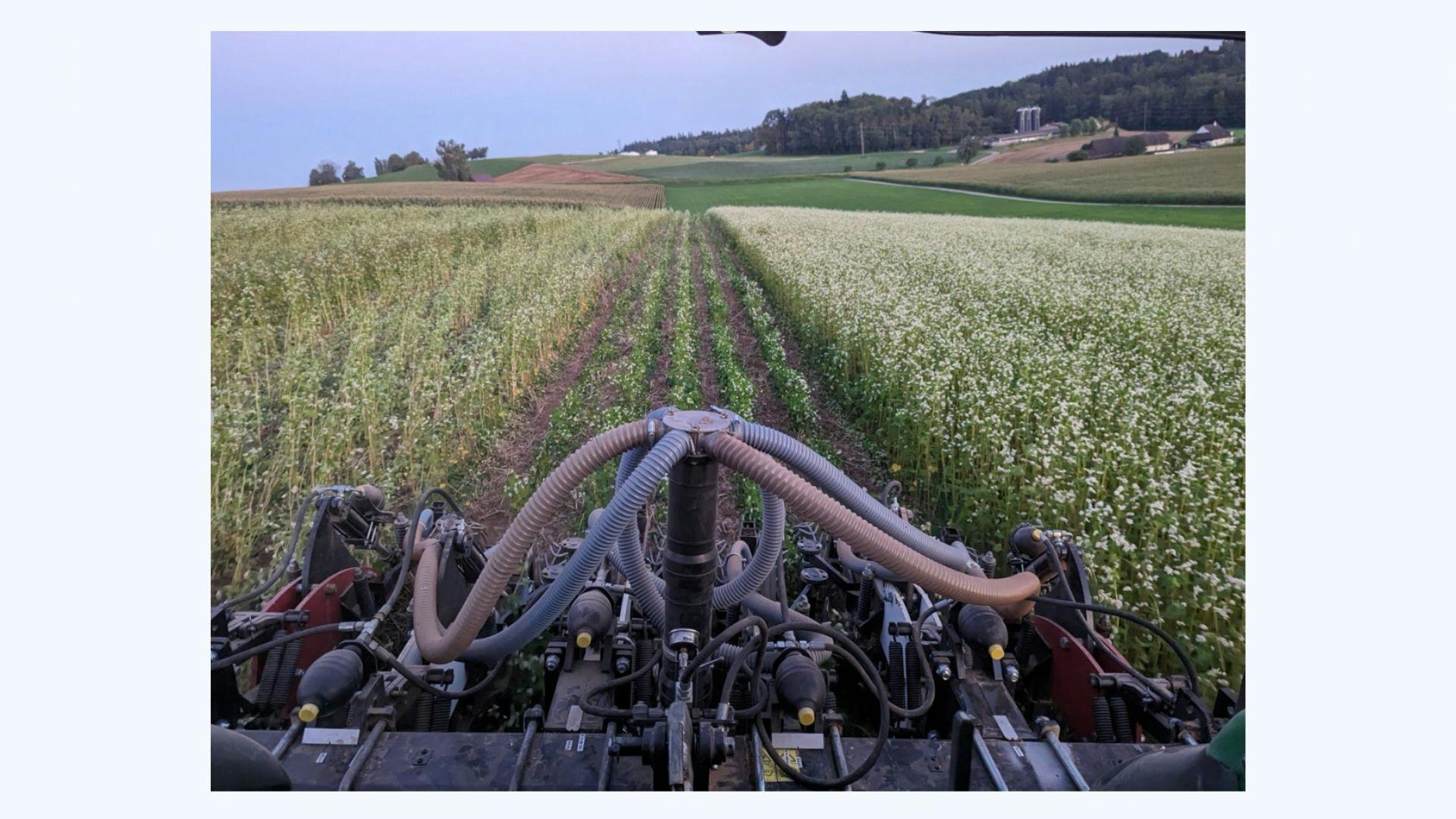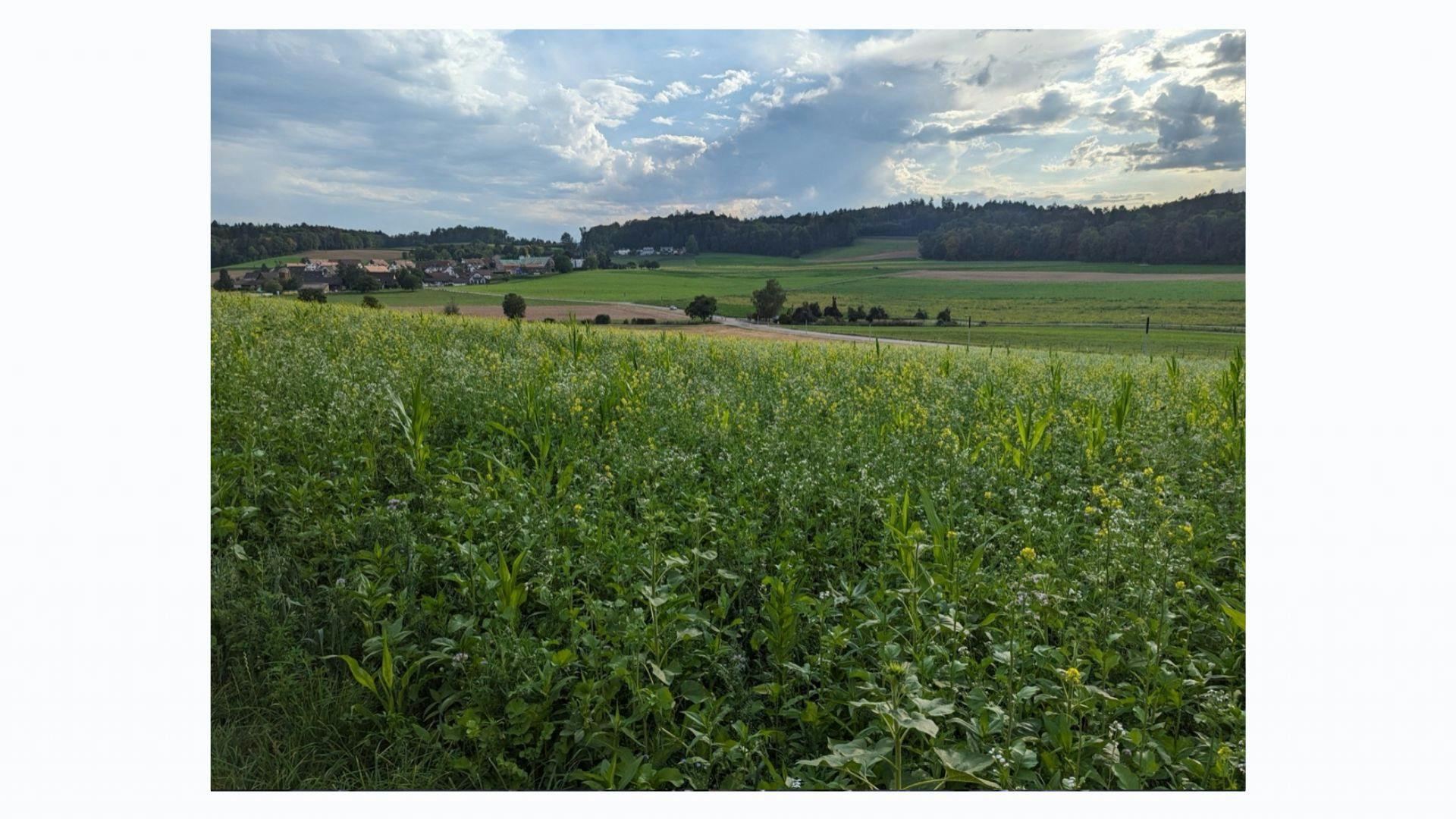Introduction
Can farming be both sustainable and productive? According to the philosophy of regenerative agriculture, the answer is yes.
Regenerative agriculture refers to an adaptive, holistic farming approach, emphasising the crucial role of healthy soils and farmland ecosystems in producing sustainable food. It differs from organic farming, which follows strict prescriptive standards for food production. Instead of specific practices, regenerative agriculture is guided by principles, with a focus on outcomes, like improving soil health and enhancing the overall quality of the land. By promoting high productivity and enhanced resilience in food production, regenerative agriculture promises to ensure environmental protection and economic stability for farmers and other food chain actors without compromising productive capacity of agricultural businesses. While farmers are increasingly interested in the topic of regenerative agriculture, the EU needs to provide an enabling policy framework for its large-scale uptake. By establishing well-targeted policy instruments through key initiatives such as the new Soil Monitoring Law, Carbon Removals Framework, and by reforming the Common Agricultural Policy (CAP), the EU could incentivise regenerative farming practices and pave the way for a sustainable agricultural future.
This interview series presents stories of farmers who are working in the space of regenerative and climate-friendly agriculture, to showcase that sustainability and productivity are indeed compatible. These interviews highlight the multifaceted benefits of regenerative farming, offers some suggestions on how to overcome challenges, and accelerate the wide uptake of climate and nature-friendly regenerative farming practices.
In this first interview, Europe Jacques Delors’ analysts Sophia Caiati and Andrea Pratelli speak with Peter Fröhlich who is a trained farmer, founder and CEO of AgriCircle, and has been involved in regenerative and traditional farming methods and their digitalisation for more than 10 years. His company, AgriCircle, enables food producers and consumers to counter climate change. An important aspect of this is providing farmer with data (including remote sensing, satellite and machinery data), showing them their current performance and clear goals in terms of sustainable management.
We met Peter Fröhlich, who is currently based in Zurich, Switzerland, at the European Alpbach Forum 2024 where he discussed together with Europe Jacques Delors Director General and Vice President Geneviève Pons how to overcome the perceived dichotomy between sustainability and productivity in the farming sector and what role regenerative agriculture can play in steering the transition towards sustainable agriculture and food systems.
Sophia: When did your personal journey with regenerative agriculture start?
Peter Fröhlich: For me, regenerative agriculture is the best farming practice. I’ve always tried to improve yields and soil health. Around six or seven years ago, I began to focus on this even more and to give it more weight. Especially over the last three to four years, I have been able to observe a real change on my farm – in terms of improved soil biodiversity, fertility and health but also my farmland has become more diverse and productive. However, I wouldn’t say I’m there yet - it's a continuous individual journey of improvement and there is still room for experimentation to explore and implement what works best.
Regenerative agriculture is a context-specific, life-enhancing process of continuous improvement.
Andrea: Regenerative agriculture has become a buzzword over the past few years. Several terms are used to describe the concept, like organic agriculture, agroecological agriculture, and so on. What is your definition of regenerative agriculture and what does it mean to you?
Peter Fröhlich: Regenerative agriculture is a context-specific, life-enhancing process of continuous improvement. In other words, regenerative farming is not a one-size-fits-all approach but a context-specific process that depends on various factors, such as soil type and soil conditions, the farm ecosystem and local microclimate, the crops, etc. It is a process that requires continuous on-farm innovation, but it will ultimately enhance your soil and crop health. Key principles of regenerative agriculture include improving soil cover, avoiding soil disturbance, keeping living roots in the soil, increasing biological diversity, and rearing livestock extensively. It is a farming model that is emphasising socioecological outcomes and results rather than just solely focusing on farming practices.

Andrea: Was there a specific reason why you decided to switch to regenerative farming practices, or was it a more gradual process?
Peter Fröhlich: I wouldn’t really call it a switch - it's more of an evolution. My farming practices evolved, leading to a complete transformation of the way I approach agriculture. The turning point was when I read a study on the evolution of the planet’s biomass productivity (1), and I realised that humanity is in deep trouble. Looking at biomass, the study found that humans have changed the planet with staggering speed, cutting global biomass nearly in half since the first agricultural revolution began roughly 12,000 years ago. This means that we are currently living off “savings” that might only last another 400 years.
Estimates of the Food and Agriculture Organization of the United Nations (FAO) show a similar 50% loss of soil organic carbon (SOC). (2) Life depends on soil organic carbon - and if there's no carbon, there’s no life, full stop. For this reason, we need regenerative agricultural practices to restore and maintain soil health.
To give you just one example: when professional soil samplers came to my fields this spring, they were swarmed with insects, unlike my neighbours' fields, where they encountered nothing. This sheer volume of life restored through regenerative practices plays a vital role in maintaining healthy soil, recycling nutrients, pollinating flowers and crops, and controlling pests. If we don't fix agriculture, society will not survive – we won’t be able to create the food we need.
Life depends on soil organic carbon - and if there's no carbon, there’s no life, full stop. For this reason, we need regenerative agricultural practices to restore and maintain soil health.
Sophia: What challenges have you faced when adopting regenerative agriculture?
Peter Fröhlich: Farming is a very traditional field, and when young farmers start out, they often follow previous generations. And when you do things differently, you become the "clown of the town". When you practice regenerative farming, your fields don’t look neat and tidy anymore, and that worries the older generation of landowners. Regenerative farmers who’ve been working for 10 or 20 years often have trouble acquiring new land for this reason; they face opposition from the more conventional farming community.
There’s also the misconception that regenerative farming does not need any production inputs such as fertilisers. One of the main advantages of adopting regenerative farming practices is the reduced need for synthetic fertiliser and gradual shift towards more biological types because in a regenerative system nutrient productivity and cycling tends to be much better than in a conventional system with depleted soils. Under the current agricultural system, we are continually depleting minerals from the soil, which are eventually consumed and lost in urban centres. Nature had a different system: animals roamed, ate, and spread nutrients back across the land. We’ve interrupted this natural cycle and circularity, and now we need to actively restore it.
When you do things differently, you become the "clown of the town"
Is regenerative agriculture going to be more expensive? Yes, because it involves rebuilding what has been depleted for years and building back is always costlier than depleting. Additionally, switching to regenerative agriculture is like starting a new farm, where mistakes are inevitable and costly, and no consultant has all the answers. But ultimately, while it will cost more, we have no alternative if we want to build a sustainable food system. This is why investing in this approach is essential.
Ultimately, while it will cost more, we have no alternative if we want to build a sustainable food system.
Andrea: Are there specific incentives - political, technological, or educational - that could encourage more farmers to adopt such regenerative practices?
Peter Fröhlich: Yes, if you take my business Agricircle for instance, we already have a system running that helps farmers learn about the best and worst agricultural practices. The greatest insights come from examining the factors that differentiate high-yield cases from low-yield ones. We do this with satellite data, comparing fields over time with regards to their regenerative agricultural performance. This helps regenerative farmers understand where their fields are underperforming and why.
In addition, we work with our own soil technology DORA (Digital Optimization and Regional Agriculture) relying on non-invasive satellite imagery, to offer farmers detailed insights into biomass and soil cover, facilitating data-driven decisions for sustainable farming practices. Then, instead of a broad sample area, we use a 10x10 meter grid to collect soil samples and analyse them with the help of artificial intelligence (AI). This gives farmers a detailed map of their soil’s health. With this information, farmers can adapt their management practices. It’s not about collecting more data - it’s about collecting the right data and using it efficiently.
At the policy level, we need to reduce the bureaucratic burden. The worst thing we can do is adopt a system that demands more data collection, as every data point costs money for the farmer. Instead, we should use those savings to fund the transition to regenerative agriculture. Farmers don't need to report every data point, but they do need incentives to move in the right direction.
When farmers can focus on actual environmental outcomes and not on paperwork related to data reporting and bookkeeping, they will surprise you. They come up with ideas that are better than anything we ever thought of. People in offices should not try to tell them how to do their jobs – that will be counterproductive. And when it comes to environmental outcomes, both highly intensive and highly extensive farms (3) tend to struggle the most, yet they dominate the political debates in Europe.
Sophia: If you would meet a farmer who considers moving towards regenerative practices, what advice would you give them?
Peter Fröhlich: The first step would be a straightforward comparison exercise and sharing best practices. First, the farmers should examine their soils; and then come to my farm, or any other farm that is using regenerative farming principles, to observe the differences in the soil quality. In many cases, their soil will be likely to appear considerably less healthy than regenerative agriculture ones, which would hopefully prompt them to reconsider whether they are on the right path. Next, I would challenge them to focus on achieving positive ecological outcomes on their land, including improving their biomass productivity and soil health on their farm more broadly. It is also important to mention that regenerative agriculture does not typically lead to lower yields or profits – you might shift costs but ultimately become more profitable because healthier soils and crops are more resilient to extreme weather events and ensure more stable yield incomes in the long-run. (4)
It is a common misconception that regenerative agriculture reduces farmers’ profitability. According to a recent study, in most in stances, farmers who adopt regenerative practices find themselves economically better off. Negative short-term impacts can occur but are often the result of uninformed trial and error. The transition to regenerative agriculture brings benefits such as reduced fertilizer, labour, and other input costswhile new sources of income can come from carbon credits; higher yields due to greater resilience in case of extreme weather events; and ultimately increased land value due to healthier soils.

Andrea: As you said, it is primarily the larger farms who are more hesitant to adopt regenerative agriculture. What strategies do you believe could encourage a greater number of them to make this transition?
Peter Fröhlich: Some farmers lack the financial flexibility to make substantial changes to their practices. The problem is that larger farms are more reliant on streamlined and simplified processes. For them, the current farming system in place is perceived as the most profitable one – so why change. Regenerative agriculture is about working with nature, which is much more time-consuming and complex. You need to spend more time on the plot, making more observations and measurements, to then adjust your practices accordingly – it's a trial-and-error process. Bigger farms simply don’t want to take the risk and change their farming approach. The larger the farm, the more streamlined and simplified the processes tend to be. Under the current farming model that subsidises farms based on size and not on environmental performance, bigger farmers simply lack the time and incentives for this transition.
Under the current farming model that subsidises farms based on size and not on environmental performance, bigger farmers simply lack the time and incentives for this transition.
Thank you for the interview!
(1) Biomass, short for biological mass, refers to the amount of living material in a specific area or volume of the Earth's surface. Several studies have compared the total material output of human activities to natural biomass, raising the possibility that human output could surpass global living biomass in the coming years. Elhacham et al. (2020), "Global human-made mass exceeds all living biomass", Nature, 588(7838). Carrington: “Humans just 0.01% of all life but have destroyed 83% of wild mammals – study”, The Guardian, 21 May 2018. Bar-On et al. (2018), "The biomass distribution on Earth”, PNAS, 115(25).
(2) Soil organic carbon is a measurable component of soil organic matter (SOM), the portion of organic residues in soil. It contributes to nutrient retention and turnover, soil structure, moisture retention and availability, degradation of pollutants, and carbon sequestration.
(3) Intensive farming involves investing significant resources and labor into small areas of land to boost yields. Extensive agriculture uses less labour and fewer resources while working on larger areas of land.
(4) It is a common misconception that regenerative agriculture reduces farmers’ profitability. According to a recent study, in most in stances, farmers who adopt regenerative practices find themselves economically better off. Negative short-term impacts can occur but are often the result of uninformed trial and error. The transition to regenerative agriculture brings benefits such as reduced fertilizer, labour, and other input costs while new sources of income can come from carbon credits; higher yields due to greater resilience in case of extreme weather events; and ultimately increased land value due to healthier soils.



